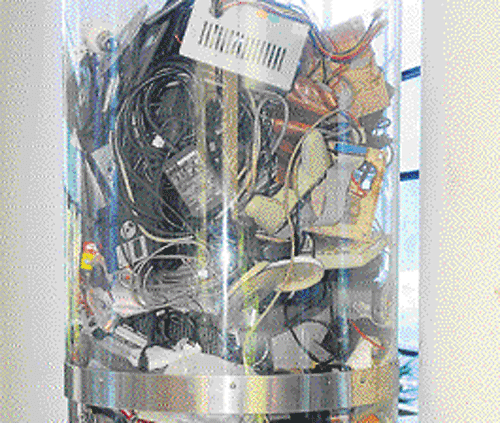The organised sector handles only 10 per cent of e-waste. The rest is handled by the unorganised sector that employs unscientific methods.
Bangalore surely basked in the global glory of its “IT hub” tag for years. Thanks to the huge IT revenues it generated and the big ticket firms that dug deep roots here, Bangalore deserved that. But now, it is wake up time. No, not from its unrelenting garbage piles or its mounting civic problems, but this time from the
rising threat of its electronic waste. Rising because, the city’s e-waste volumes are
going beyond 18,000 metric tonnes per annum, an astounding piece of statistic brought home by a recent Assocham survey.
The explosive growth of IT industries in the City has inevitably triggered a
dramatic increase in the number of bulk consumers of electronic equipment. This has given a huge push to a populace that is intensely tech-savvy, brand conscious in gadgetry and conspicuous in their consumption.
So, if the city’s estimated 2,700 software firms, 35 hardware manufacturing units and hundreds of small-scale industries generate tonnes of e-waste daily, it finds an echo among the individual and household consumers. Television sets and refrigerators, washing machines and mobile phones are discarded at a much higher frequency than before. Everybody wants the latest, but are they too concerned about what happens to the old?
Recycling of electrical and electronic waste is still a largely alien concept to
Indians, and Bangaloreans are no different. Due to high refurbishment and reuse of such products among households, only small quantities of e-waste are destined for recycling. As a Karnataka State Pollution Control Board (KSPCB) official observes, “You hardly see any such waste getting dumped. People either dump it somewhere in their backyard, or give them to their servants.”
A few television manufacturers have a buy-back policy in place, where old Cathode Ray Tubes (CRT) are sent for recycling. Some big players in the consumer durables sector also have a system of taking back old refrigerators and other household items through auctions. At least one IT major has adopted a practice of releasing discarded computers to its employees, or donating them for charity through Rotary Clubs. But these measures, however emulation-worthy, are exceptions and not the rule.
Poor awareness
The awareness of a formal recycling system for e-waste, although put in place by the KSPCB five years ago, is still in its infancy. According to one estimate, about 90 per cent of the consumers, both bulk and household, depend on the recyclers in the informal sector, who lack the expertise or equipment to handle the e-waste in a scientific manner.
Hundreds of such firms operate in the City, where lowly-paid workers employed in poorly-protected environments burn e-waste in the open, releasing lead, mercury and other toxins into the air.
Strong acids are used to extract precious metals including gold from the discarded electronic items. The stuff that cannot be extracted are just dumped into the drains and garbage. Eventually, this leads to ground water pollution and bigger health risks.
The system is apparently too entrenched in the City to break. The trading chain of backyard practitioners is big. As a KSPCB-authorised recycling unit head informs, there is a unholy nexus between these backyard practitioners (the unorganised e-waste recyclers, to be precise), government officials, and e-waste suppliers. An estimated 4,000 such practitioners thrive in the City, masquerading as mere scrap-dealers. KSPCB officials cannot pinpoint their locations, but are sure that the operational areas include Goripalya near Mysore Road, Shivajinagar, DJ Halli, KG Halli, Tannery Road and Bommanahalli in the City.
Illegal recyclers
Clearly, these recyclers are illegal and ought to be taken off the map since their activities blatantly violate the provisions of the e-waste (Management and Handling) Rules, 2011, notified by the Union Ministry of Environment and Forests, under the Environment (Protection) Act, 1986.
The legislation’s implementation began on May 1, 2012. The specified rules are applicable to all stakeholders in the e-waste management value chain, such as the producer, distributor, collection centre, refurbisher, dismantler, recycler, consumer and bulk consumer involved in the manufacture, sale, purchase, and processing of electronic and electrical equipment or components. Non-compliance with the rules should invite penalty and punishment under Section 15 of the Environment (Protection) Act, 1986. A consumer includes even an individual who purchases an electronic equipment.
But there is a catch. KSPCB has authorised 27 dismantlers and recyclers under the 2011 Rules to manage the e-waste generated in the city and its surroundings. However, micro and small enterprises (MSEs) are exempt from the responsibility of obtaining KSPCB authorisation to assess the quantity of their e-waste. “The bulk of the e-waste that goes to these 27 recyclers are generated by the MSEs. For the Rules to work well, such exemptions for MSEs should be removed,” contends the Board official.
Although the capacity is in place in the formal sector to handle e-waste of high volumes, the inflow is only about 10 per cent of the total e-waste generated in the City. Once this increases, the bulk consumers could fully utilise the infrastructure put in place by the recyclers, the biggest of whom is the Dobbespet-based e-Parisara.
e-Parisara is India’s first e-waste recycling unit, which started operation in 2004. It currently deals with about 350 customers of repute on B2B operation. The recycler is a leading player in the recovery of apparent gold and silver, which is in turn used in electroplating of watches, and pen parts. It could be contacted on toll free number 1800 425 35287.
